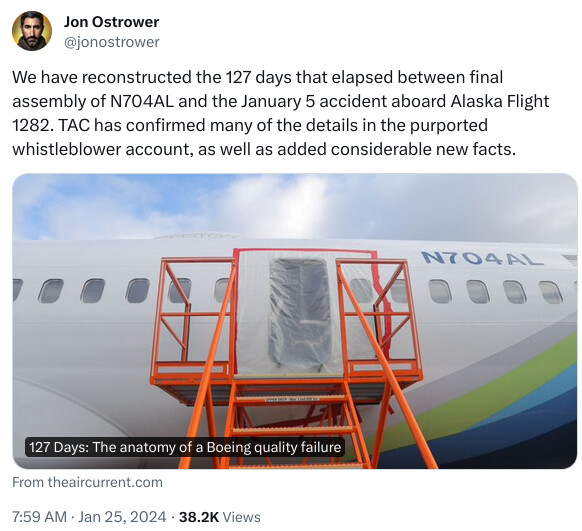Chris Brady has posted an even deeper dive into the operation of the 737 plug door attachment mechanism and the statements by Boeing and the aftermarket installer of the Wi-Fi system on the accident plane as to their use of the door. If you’ve wondered how, precisely, guide tracks and pins and stop fittings work to keep the door in place, now you’ll know. Also, why the 737-900ER with essentially the same plug door was not included in the Airworthiness Directive that grounded the MAX-9.
Boeing 737 MAX 9 Part in Plane Blowout Was Made in Malaysia, Official Says
Jennifer Homendy, chair of the National Transportation Safety Board, said Wednesday that Spirit
AeroSystems produced the door plug in Malaysia before it wound up in the Boeing supplier’s Wichita, Kan., factory, and eventually on a train to the plane maker’s 737 factory in Renton, Wash., near Seattle.
The hide the ball that they play with information is annoying and complicated by media incompetence in not asking relevant questions.
Was the component built in Malaysia just the door or was it an assembly of door and frame?
My guess is that had they just put detailed photos of the frame and the recovered door on the internet, collective wisdom would have already converged on the cause.
737-900ER
It was an Airbus, but fits the theme:
Virgin Atlantic is the airline which staged “the UK’s first-ever Pride Flight from London to NYC in June 2019 to celebrate World Pride”.

Is it any wonder they’re virgins? Or that there are screws loose on their airplanes?
We are living in nut world.
What caricatures!
With screws lose!
Can anything save Boeing from its management? The recent high-profile near-disaster involving an Alaska Airlines Boeing 737-9 MAX is just another small step in Boeing’s downward spiral, and it is far from clear what will arrest it.
The safety concerns and manufacturing errors plaguing the company’s jetliner unit are just part of the problem. The production ramp-up has been a series of disappointments that will only worsen as regulators and customers scrutinize manufacturing and inspection processes.
The company is also quickly losing market share. CEO Dave Calhoun’s November 2022 announcement that there would be no new Boeing jetliner this decade had a predictable result: a record 1,300 Airbus A321neo orders in 2023. Boeing will be very lucky to retain 40% of the market by decade’s end. Given relentless cost-cutting and the demographics of the engineering workforce, it will be quite difficult for the company to create a new jetliner in the 2030s.
⋮
As 2023 ended, the company’s strategy department was abolished. Unit strategy functions were also reduced. The company no longer wants a plan for company-wide new technology development, new product development or, most crucial, restoring the links between the people who design and build aircraft and the people who manage the company. There are also no plans to promote technical people to senior management positions. Stephanie Pope’s recent appointment as chief operating officer means another finance person has been made Calhoun’s heir apparent.
The future, if it can be called that, is simply to run the company for cash—deliver legacy jets, try to make existing defense programs profitable, and resume converting cash flow into shareholder returns. Management may also try to sell off parts of the company—or perhaps all of it. The implications of this for the U.S. aerospace industry, defense industrial base and even the broader economy are potentially enormous.
A couple of years back, Boeing’s Annual Report prominently featured a photograph of the then-CEO with the key new hires – mostly females and people of color; 2 or 3 out of about 30 were token white males. It definitely did not look like America – and certainly not like the graduates of top engineering colleges.
Live by the DIE, die by the DIE. There is a lot of ruin in a nation – and in a once-preeminent organization like Boeing – but not an infinite amount of ruin.
The steel-making industry has long gone to China, followed by shipbuilding, and electronics, and now automobile manufacturing. If we look at the tea leaves, aircraft manufacturing is on the path to follow. And yet none of our Political Class in the US (or more generally in the West) care about this de-industrialization.
“But we can buy it much cheaper from China!”
The Seattle Times is reporting “Boeing, not Spirit, mis-installed piece that blew off Alaska MAX 9 jet, industry source says”.
The fuselage panel that blew off an Alaska Airlines jet earlier this month was removed for repair then reinstalled improperly by Boeing mechanics on the Renton final assembly line, a person familiar with the details of the work told The Seattle Times.
If verified by the National Transportation Safety Board investigation, this would leave Boeing primarily at fault for the accident, rather than its supplier Spirit AeroSystems, which originally installed the panel into the 737 MAX 9 fuselage in Wichita, Kan.
⋮
Last week, an anonymous whistleblower — who appears to have access to Boeing’s manufacturing records of the work done assembling the specific Alaska Airlines jet that suffered the blowout — on an aviation website separately provided many additional details about how the door plug came to be removed and then mis-installed.
“The reason the door blew off is stated in black and white in Boeing’s own records,” the whistleblower wrote. “It is also very, very stupid and speaks volumes about the quality culture at certain portions of the business.”
The self-described Boeing insider said company records show four bolts that prevent the door plug from sliding up off the door frame stop pads that take the pressurization loads in flight, “were not installed when Boeing delivered the airplane.” the whistleblower stated. “Our own records reflect this.”
⋮
Boeing’s 737 production system is described as “a rambling, shambling, disaster waiting to happen.”
⋮
The Seattle Times offered Boeing the opportunity to dispute the details in this story. Citing the ongoing investigation, Boeing declined to comment. Likewise, so did Spirit, the FAA, the Machinists union and the NTSB.
[Alaska Airlines] CEO Ben Minicucci said that a new in-house inspection of the Boeing model in the fleet has uncovered that “many” of the planes had loose bolts.
“I’m angry. I’m more than frustrated and disappointed. I am angry,” Minicucci told NBC News Tuesday. “This happened to Alaska Airlines. It happened to our guests and happened to our people.
“And my demand on Boeing is what are they going to do to improve their quality programs in-house,” he added. “Boeing is better than this. Flight 1282 should never have happened.”
⋮
The CEO said that while the airline “was” planning to buy MAX 10s, the carrier will now evaluate “what the best long-term strategic plan is for Alaska(‘s) fleet mix” once the plane is certified.
Boeing will get sued big time and will lose big time if any of various conduct occurred with knowledge.
False statements to officials.
Defamation or unfair trade practices re. Spirit:
Stock manipulation:
https://seekingalpha.com/news/4057872-spirit-aerosystems-rises-on-media-report-of-possible-boeing-errors
The TAC article suggests the seal replacement was an effect of having to open the plug, not the reason for.
What’s it with not being able to drill the correct size hole?




